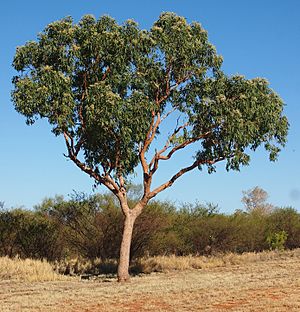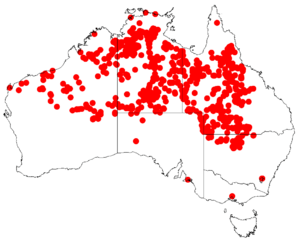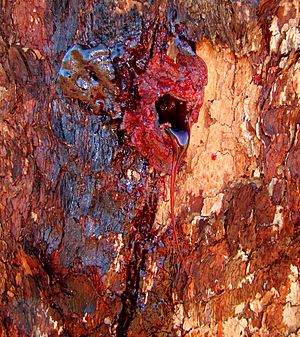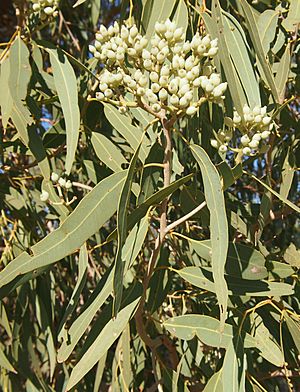Tjuta facts for kids
Quick facts for kids Tjuta |
|
|---|---|
 |
|
| Scientific classification | |
| Genus: |
Corymbia
|
| Species: |
terminalis
|
 |
|
| Occurrence data from Australasian Virtual Herbarium (including that of C. opaca | |
| Synonyms | |
|
|

Corymbia terminalis, also known as tjuta or bloodwood, is a special tree found only in Australia. It's usually a small to medium-sized tree, but sometimes it grows as a mallee, which is a shrubby plant with many stems from the ground. This tree has rough bark on its trunk and sometimes on its bigger branches. The bark higher up is smooth and can be white or cream-colored. It has long, lance-shaped leaves, white flowers, and fruit shaped like an urn.
Contents
What the Tjuta Tree Looks Like
The Tjuta tree typically grows up to about 18 meters (59 feet) tall. It has a special woody swelling at its base called a lignotuber. This helps the tree regrow after fires or damage.
Its bark is rough and looks like a mosaic (tessellated). It can be light brown or light grey. This rough bark covers part or all of the trunk and sometimes goes up to the larger branches. The bark higher up is smooth and can be white or cream.
Young Tjuta trees and new shoots have egg-shaped or lance-shaped leaves. These leaves are about 6 to 17 centimeters (2.4 to 6.7 inches) long and 1.2 to 4.5 centimeters (0.5 to 1.8 inches) wide. They have a stalk called a petiole and grow in pairs opposite each other.
Adult leaves are arranged differently. They are the same grey-green color on both sides and are lance-shaped. They measure about 8 to 20 centimeters (3.1 to 7.9 inches) long and 1.2 to 3 centimeters (0.5 to 1.2 inches) wide. Their petioles are about 1 to 3 centimeters (0.4 to 1.2 inches) long.
Flowers and Fruit
The Tjuta tree's flowers grow in groups of seven at the ends of its branches. Each group of flowers is on a stalk called a peduncle, which is about 5 to 20 millimeters (0.2 to 0.8 inches) long. Each individual flower bud has its own small stalk, called a pedicel, about 2 to 13 millimeters (0.1 to 0.5 inches) long.
The mature flower buds are oval or pear-shaped. They can be greenish, brown, or cream-colored. They are about 6 to 14 millimeters (0.2 to 0.6 inches) long and 5 to 10 millimeters (0.2 to 0.4 inches) wide. Each bud has a cap called an operculum, which can be cone-shaped, rounded, or flat.
Tjuta trees usually flower between March and October. Their flowers are white. After flowering, the tree produces woody, urn-shaped fruit. This fruit is a capsule about 15 to 31 millimeters (0.6 to 1.2 inches) long and 12 to 22 millimeters (0.5 to 0.9 inches) wide. It sits on a pedicel about 2 to 12 millimeters (0.1 to 0.5 inches) long. The seeds inside are light brown or reddish-brown and have a small wing on one end.
How the Tjuta Tree Got Its Name
The Tjuta tree was first officially described in 1859 by a scientist named Ferdinand von Mueller. He called it Eucalyptus terminalis. He wrote about it in a science journal after collecting samples in the Northern Territory in 1856.
Later, in 1995, two other botanists, Ken Hill and Lawrie Johnson, changed its name to Corymbia terminalis. They published this new name in a journal called Telopea.
The word terminalis comes from Latin and means "terminal" or "at the end." This refers to how the flowers grow at the very ends of the branchlets, outside the main leafy part of the tree.
Where the Tjuta Tree Grows
This type of eucalypt tree lives in dry and sometimes wet areas of Australia. You can find it in the Northern Territory, Queensland, the northwest part of New South Wales, and the very north of South Australia. Another similar tree, Corymbia opaca, which is sometimes grouped with C. terminalis, grows in the northern half of Western Australia.
The Tjuta tree likes to grow on flat areas near rivers, on rocky slopes, and in sandy valleys between dunes. It prefers soil that drains water well. It can also handle both drought (very dry periods) and frost.
Tjuta Tree's Role in Nature
The flowers of the Tjuta tree produce sweet nectar. This nectar is a great source of energy for many desert animals. These include honeyeaters (birds), various insects, and possums.
The tree is also home to a unique insect called a coccid. This female insect burrows into the tree's bark and creates a special growth called a gall. Once inside, it never leaves. It stays hidden and drinks sap from the tree's veins. The gall it creates is sometimes called a "coconut." If you break it open, you can find the insect inside. It's known to contain a lot of moisture and can even act as a disinfectant.
Traditional Uses of the Tjuta Tree
Indigenous Australians have used the Tjuta tree for many purposes, including traditional medicine.
- Medicine from Sap: The sticky sap, called exudate, that comes out of the trunk or branches was mixed with water. This mixture was then used as an antiseptic to treat cuts and sores on the face. Larger leaves were also used to help stop bleeding from wounds.
- Medicine from Bark: The red sap from the bark, called kino, could be peeled off the tree and mixed with water. People would drink this mixture to help with diarrhoea, indigestion, and chest pain.
- Tools and Materials: The wood from the Tjuta tree was very useful. Indigenous peoples used it to make spear-throwers (tools for throwing spears), digging bowls, and carrying vessels. Later, European settlers also used the wood for building things like fence-posts, floor supports, and parts of buildings. It was also a good source of firewood.
See also
 In Spanish: Corymbia terminalis para niños
In Spanish: Corymbia terminalis para niños



